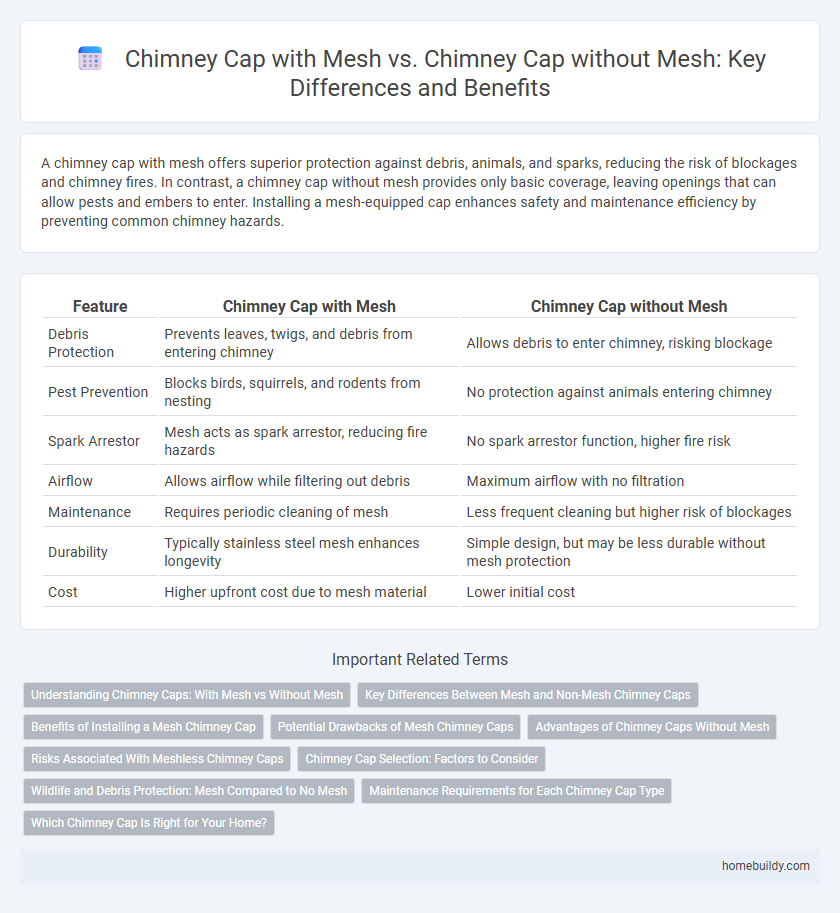A chimney cap with mesh offers superior protection against debris, animals, and sparks, reducing the risk of blockages and chimney fires. In contrast, a chimney cap without mesh provides only basic coverage, leaving openings that can allow pests and embers to enter. Installing a mesh-equipped cap enhances safety and maintenance efficiency by preventing common chimney hazards.
Table of Comparison
| Feature | Chimney Cap with Mesh | Chimney Cap without Mesh |
|---|---|---|
| Debris Protection | Prevents leaves, twigs, and debris from entering chimney | Allows debris to enter chimney, risking blockage |
| Pest Prevention | Blocks birds, squirrels, and rodents from nesting | No protection against animals entering chimney |
| Spark Arrestor | Mesh acts as spark arrestor, reducing fire hazards | No spark arrestor function, higher fire risk |
| Airflow | Allows airflow while filtering out debris | Maximum airflow with no filtration |
| Maintenance | Requires periodic cleaning of mesh | Less frequent cleaning but higher risk of blockages |
| Durability | Typically stainless steel mesh enhances longevity | Simple design, but may be less durable without mesh protection |
| Cost | Higher upfront cost due to mesh material | Lower initial cost |
Understanding Chimney Caps: With Mesh vs Without Mesh
Chimney caps with mesh provide enhanced protection against debris, animals, and sparks, reducing fire hazards and blockages in the flue. In contrast, chimney caps without mesh primarily prevent water infiltration but do not offer the same level of defense against pests or embers. Choosing between mesh and non-mesh chimney caps depends on the need for comprehensive ventilation safety and pest control.
Key Differences Between Mesh and Non-Mesh Chimney Caps
Chimney caps with mesh provide enhanced protection against animals, debris, and sparks by acting as a physical barrier, reducing the risk of blockages and fires. Non-mesh chimney caps primarily prevent rain and downdrafts but lack the screening function, making them less effective at stopping birds and small animals from entering the flue. Mesh caps typically improve safety and ventilation while requiring periodic cleaning to prevent creosote buildup, whereas non-mesh caps offer simpler maintenance but limited defense against external intrusions.
Benefits of Installing a Mesh Chimney Cap
A chimney cap with mesh provides essential protection by preventing animals, debris, and leaves from entering the chimney, reducing the risk of blockages and potential fires. The mesh also acts as a spark arrestor, minimizing the chances of sparks escaping and igniting nearby structures. In contrast, a chimney cap without mesh lacks these safety features, making the mesh design the superior choice for maintaining chimney safety and efficiency.
Potential Drawbacks of Mesh Chimney Caps
Mesh chimney caps can trap soot and creosote more quickly, increasing cleaning frequency and maintenance costs. The mesh restriction may reduce draft efficiency, causing smoke to enter the home or chimney backdraft issues. Small mesh holes can become clogged with debris, requiring regular inspection to prevent blockages and fire hazards.
Advantages of Chimney Caps Without Mesh
Chimney caps without mesh provide superior airflow and reduce creosote buildup by allowing smoke and gases to escape more efficiently. These caps minimize obstructions, lowering the risk of sparks igniting debris or leaves compared to mesh-covered caps. They also require less maintenance, as there is no mesh to clean or replace, making them a practical choice for homeowners prioritizing low upkeep and optimal ventilation.
Risks Associated With Meshless Chimney Caps
Chimney caps without mesh pose significant risks including the intrusion of animals such as birds, squirrels, and raccoons, which can block flues or cause nests that increase fire hazards. These meshless caps also allow embers and debris to enter the chimney, raising the risk of chimney fires and structural damage. Installing a chimney cap with a durable mesh screen effectively prevents these dangers by providing a barrier against pests and reducing the chance of flying embers igniting surrounding materials.
Chimney Cap Selection: Factors to Consider
Choosing between a chimney cap with mesh and one without depends on factors such as pest prevention, ventilation needs, and maintenance requirements. A chimney cap with mesh effectively blocks birds, animals, and debris while allowing proper airflow, enhancing safety and efficiency. Conversely, a cap without mesh offers minimal obstruction, suitable for locations with low pest risk but may require more frequent cleaning to avoid blockages.
Wildlife and Debris Protection: Mesh Compared to No Mesh
A chimney cap with mesh significantly enhances wildlife protection by preventing birds, squirrels, and other small animals from entering and nesting inside the chimney, unlike caps without mesh that leave openings vulnerable. The mesh also acts as an effective barrier against debris such as leaves, twigs, and other foreign materials that could obstruct airflow or cause fire hazards. Choosing a chimney cap with mesh improves safety and chimney functionality by reducing blockages and protecting wildlife habitats.
Maintenance Requirements for Each Chimney Cap Type
Chimney caps with mesh require regular cleaning to prevent creosote buildup and ensure the mesh remains unobstructed for proper airflow and animal prevention. Chimney caps without mesh demand less frequent cleaning but offer reduced protection against debris and animals, potentially increasing maintenance caused by blockages. Choosing caps with mesh balances maintenance needs with enhanced chimney protection and safety.
Which Chimney Cap Is Right for Your Home?
A chimney cap with mesh provides enhanced protection by preventing animals, debris, and sparks from entering the chimney, reducing fire hazards and blockages. A chimney cap without mesh offers basic coverage to keep out rain and downdrafts but lacks crucial screening features that protect the flue and chimney structure. Choosing the right chimney cap depends on factors like local wildlife presence, weather conditions, and chimney type, with mesh caps often preferred for comprehensive safety and ventilation.
Chimney cap with mesh vs Chimney cap without mesh Infographic

 homebuildy.com
homebuildy.com